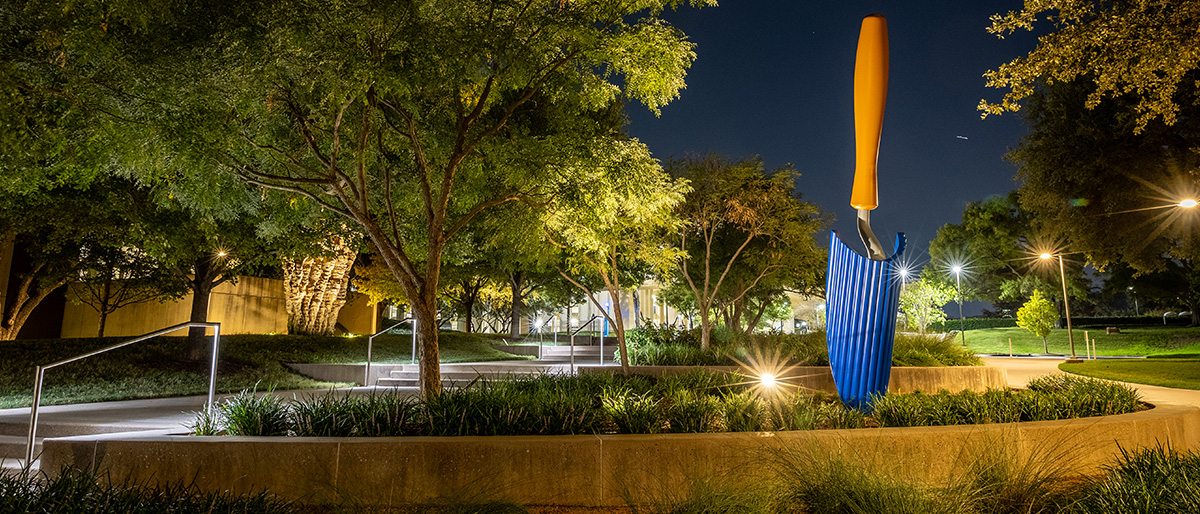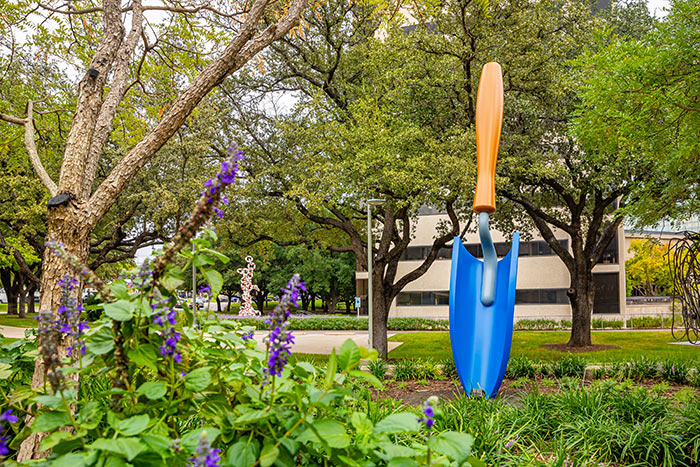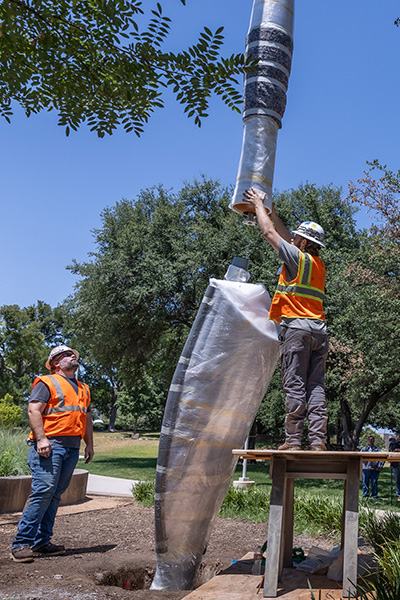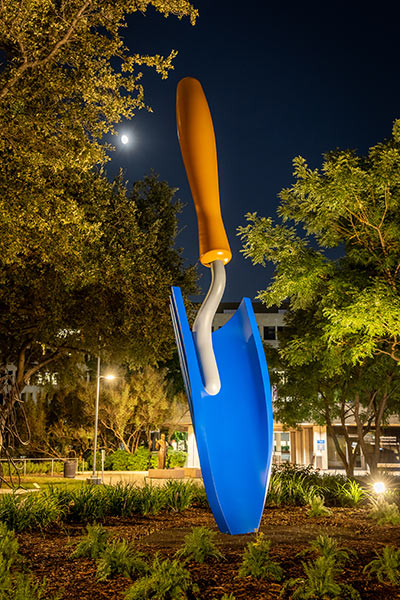Whimsical piece in sculpture garden collection gets to the root of artistic inspiration
Sixth donation from Nobel Laureate builds striking outdoor collection on South Campus

Someone passing the sculptures on Dr. Donald Seldin Plaza on South Campus might wonder what some of the modern art pieces are meant to depict: one a framework of colorful beams, another an organic mass of bronze with a delicate patina.
There’s no mistaking what the newest piece is, however, since a 15-foot blue garden trowel is hard to misinterpret.
Plantoir, Blue (Mid-Scale), by the late Claes Oldenburg and Coosje van Bruggen, is the sixth outdoor piece donated to UT Southwestern by Nobel Laureate Joseph Goldstein, M.D., Chair of Molecular Genetics.

“The shift in tone is largely due to Dr. Goldstein – he loves color and wit, and I think he was keen to include playful pieces, in addition to the more restrained bronze works,” said Courtney Crothers, Art Curator for UTSW. “The collection as a whole is aspirational. It reflects UT Southwestern’s standard for excellence and Dr. Goldstein’s dedication to the institution as well as his belief in the value of fine art to inspire and uplift.”
Dr. Goldstein and his 50-year lab partner, Nobel Laureate Michael Brown, M.D., Professor of Molecular Genetics and Director of the Erik Jonsson Center for Research in Molecular Genetics and Human Disease, shared the 1985 Nobel Prize in Physiology or Medicine for their discovery of the low-density lipoprotein receptor and its role in cholesterol metabolism. To Dr. Goldstein, science and art are not so dissimilar, as both require creativity.

“The oversized nature of the trowel hopefully will challenge viewers to think big and give thought to how important scientific discoveries come about, i.e., by weeding out the bad data and digging deeper and deeper to unearth the good data that reveals the truth,” Dr. Goldstein said.
Icons of the Pop Art movement, Mr. Oldenburg and Ms. van Bruggen were known for rendering ordinary objects at a monumental scale – a clothespin, typewriter eraser, binoculars, ice cream cone, bowling pins. Mr. Oldenburg was overseeing the construction of the newly installed Plantoir, Blue (Mid-Scale) when he died in 2022 at age 93. It is one of several versions of the sculpture, which has been fabricated in various sizes.
Their work in “monumental and whimsical” sculpture set them apart from other Pop artists, who mostly worked in paintings, Dr. Goldstein said.
With Plantoir, Blue (Mid-Scale) as the final creation to have Mr. Oldenburg’s personal involvement, “It’s going to have a place in history,” said art consultant Talley Dunn, the owner of Talley Dunn Gallery, who worked with Dr. Goldstein in acquiring the six sculptures.

“Plantoir, Blue (Mid-Scale) is a perfect addition to our outdoor sculpture collection. It can be looked at – literally and figuratively – from many perspectives,” said UT Southwestern President Daniel K. Podolsky, M.D. “We are extremely grateful to Dr. Goldstein for his generosity, and through it, the addition of this unique sculpture that can inspire all who come to campus.”
All the pieces are installed in or near Seldin Plaza: Elmgreen & Dragset’s Life Rings, Fig. 2, a monumental arrangement of red-and-white life preservers stretching skyward; Dumna by Ursula von Rydingsvard; two untitled geometric forms by Joel Shapiro; and an untitled steel and copper sculpture by Christopher Wool, inspired by tangles of fencing wire.
The Plaza also contains a bronze sculpture of Dr. Seldin, first Chair of Internal Medicine and one of the guiding forces in UT Southwestern’s history.
Dr. Brown, a Regental Professor, holds the W.A. (Monty) Moncrief Distinguished Chair in Cholesterol and Arteriosclerosis Research and the Paul J. Thomas Chair in Medicine.
Dr. Goldstein, a Regental Professor, holds the Julie and Louis A. Beecherl, Jr. Distinguished Chair in Biomedical Research and the Paul J. Thomas Chair in Medicine.
Dr. Podolsky holds the Philip O’Bryan Montgomery, Jr., M.D. Distinguished Presidential Chair in Academic Administration, and the Doris and Bryan Wildenthal Distinguished Chair in Medical Science.

